Soldier Story: Yoshio Iwamasa
Soldier Story
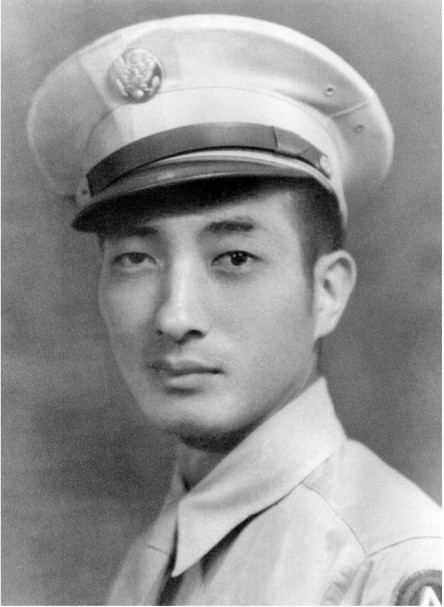
Yoshio Iwamasa
Private First Class
442nd Regimental Combat Team
3rd Battalion, I Company
Yoshio Iwamasa was born on January 14, 1915, in Niulii, North Kohala District, Hawaii island, Territory of Hawaii. He was one of the eleven children of Matsuemon and Tsugi (Hirotsu) Iwamasa: sons Sadaichi, Yasuichi, Masaichi, Haruto, Takeo, Masao, Yoshio, and Matsuto, and daughters Sumiyo, Patsy Tsuruyo, Fusako.
His parents arrived from Yamaguchi Prefecture, Japan, in 1898, after marrying the previous year. They settled in North Kohala, where they worked as vegetable farmers. By 1920, Matsuemon was working as a laborer on the Halawa sugar plantation.
Yoshio was educated at Makapala School, and Kohala Elementary and High Schools. He registered for the draft on October 26, 1940, at Local Board No. 4 in nearby Kamuela (also known as Waimea). His mother, Tsugi, who lived in Makapala, was listed as his point of contact He lived in Mahukona and was employed as a warehouse clerk by the Kohala Sugar Company in Hawi. He was 5’6¾” tall and weighed 125 pounds.
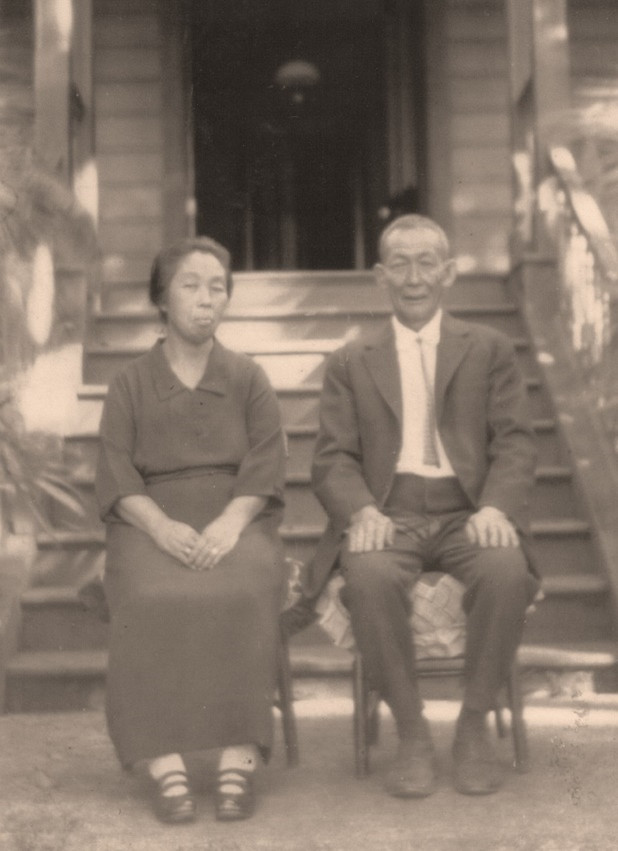
Photos taken about 1940 at family home in Niulii.
Above: Tsugi and Matsuemon.
Below: Iwamasa children, clockwise from bottom left: Patsy, Sumiyo, Take, Sadaichi, Yasuichi, Haruto, Masao, Fusako, and Matsuto. In the center above Matsuto are Yoshio and Masuichi.
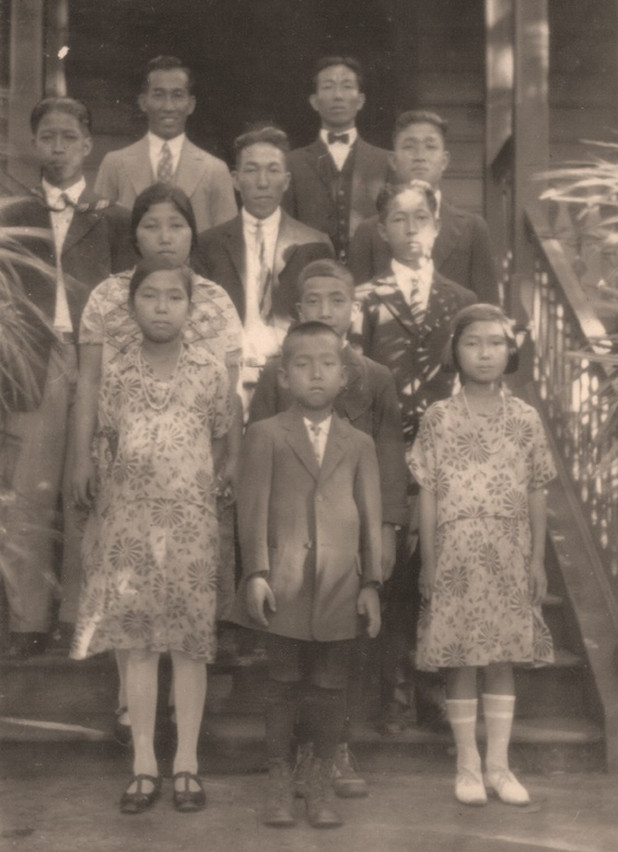
Yoshio’s name was among those of 30 volunteers who were selected from Local Board No. 4 for enlistment into the U.S. Army. At the Kohala Theater on March 16, 1943, the local community gave them a farewell before they left home. The event was hosted by J. Scott B. Pratt, Manager of Kohala Sugar Company. A lei was given to each volunteer, and a check from the company to their employees in the group. After Mr. Pratt gave a farewell speech, Kinichi Sakai, a U.S. Army captain in World War I, spoke of how he enjoyed Army life and expressed his wish to be able to go again. Yoshio was asked to say a few words on behalf of the young men. After thanking the event sponsors, he said, “We are proud to have been selected and we are sure your confidence in us will not be misplaced. To you folks who remain at home, we say, ‘Keep in good spirits and keep the home fires burning until we meet again.’” After Mr. Pratt led the crown in three rousing cheers, everyone sang God Bless America. The Walter Rodenhurst troupe provided Hawaiian music during the evening.
Yoshio Iwamasa enlisted in the Army at Hilo, Hawaii island, on March 18, 1943. At the time he was working as a clerk at Standard Oil Company in Mahukona. He was sent to the “tent city” known as Boom Town at Schofield Barracks with the other recruits. They were given a farewell aloha ceremony by the community on March 28 at Iolani Palace. On April 4, the new soldiers left on the S.S. Lurline for San Francisco enroute to Camp Shelby, Mississippi.
Yoshio was assigned to 3rd Battalion, I Company. After a year of basic, combat, and specialty training and maneuvers, he left with the rest of the 442nd on April 22 for Camp Patrick Henry Virginia. They sailed to Theater of War on May 2, 1944, from nearby Hampton Roads, and arrived at Naples on May 28. They entered combat near Suvereto – in the Rome-Arno Campaign in Italy – on June 26. He served in all of the campaigns with the battalion: Rome-Arno Campaign in Italy, Rhineland-Vosges Campaign and Rhineland-Maritime Alps Campaign in France, and Po Valley Campaign back in Italy.
While in the Vosges, Yoshio fought in the liberation of the important road junction of Bruyères and the rescue of the “Lost Battalion” – the 1st Battalion of the 141st (Texas) Infantry, which had advanced beyond its support and become surrounded by the enemy. During the fierce fighting on October 29, Iwamasa was in the “Banzai” charge initiated by Barney Hajiro up what was later nicknamed “Suicide Hill.” As he charged forward, he was screaming such obscenities as “you f***** Jerries!” along with the other men.
Yoshio was wounded in November 1944 in the battles around Saint-Dié (full name Saint-Dié-des-Vosges), during the Vosges Campaign.
Following the Vosges, the 442nd was understrength for combat due to the heavy casualties it had sustained. They were sent to the south of France for fighting in the Rhineland-Maritime Alps Campaign. The was primarily a mission of maintaining a defensive position to guard against enemy incursion from Italy to the east. The 442nd was in the area of Nice, Menton, Sospel, L’Escarène, and Peira Cava, and they received replacements during this time. The period was relatively calm and was nicknamed the “Champagne Campaign.”
Below: Taken during the Champagne Campaign in late 1944/early 1945; in each photo, Iwamasa is on the far left (Courtesy of Kim Muramoto Jr. Family Collection, Densho)
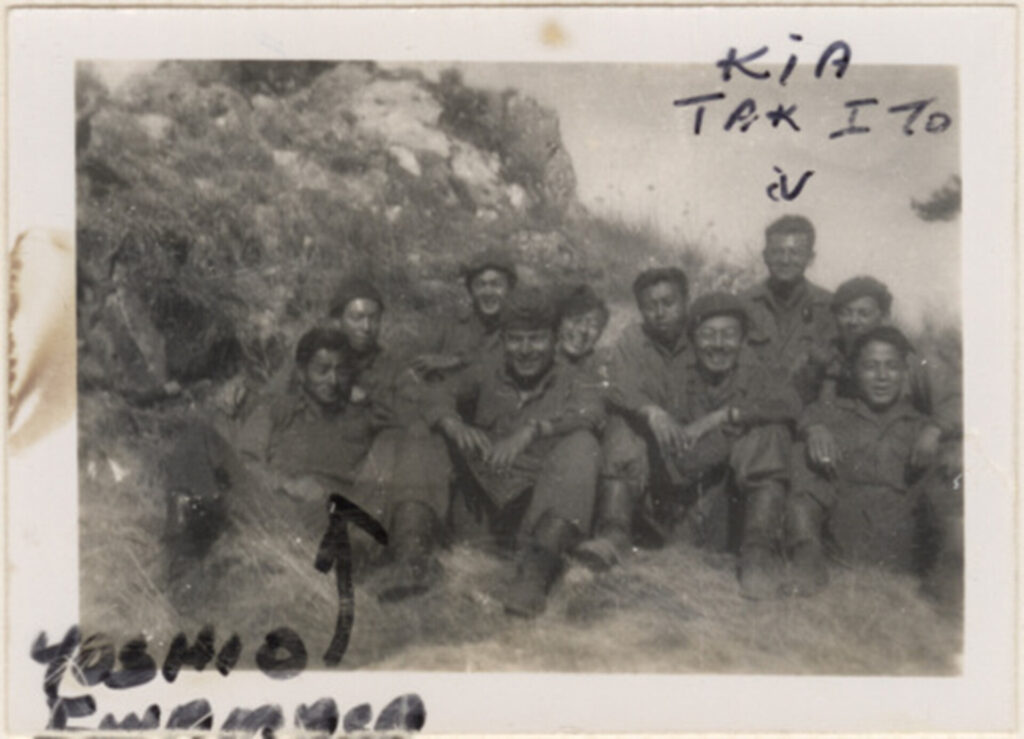
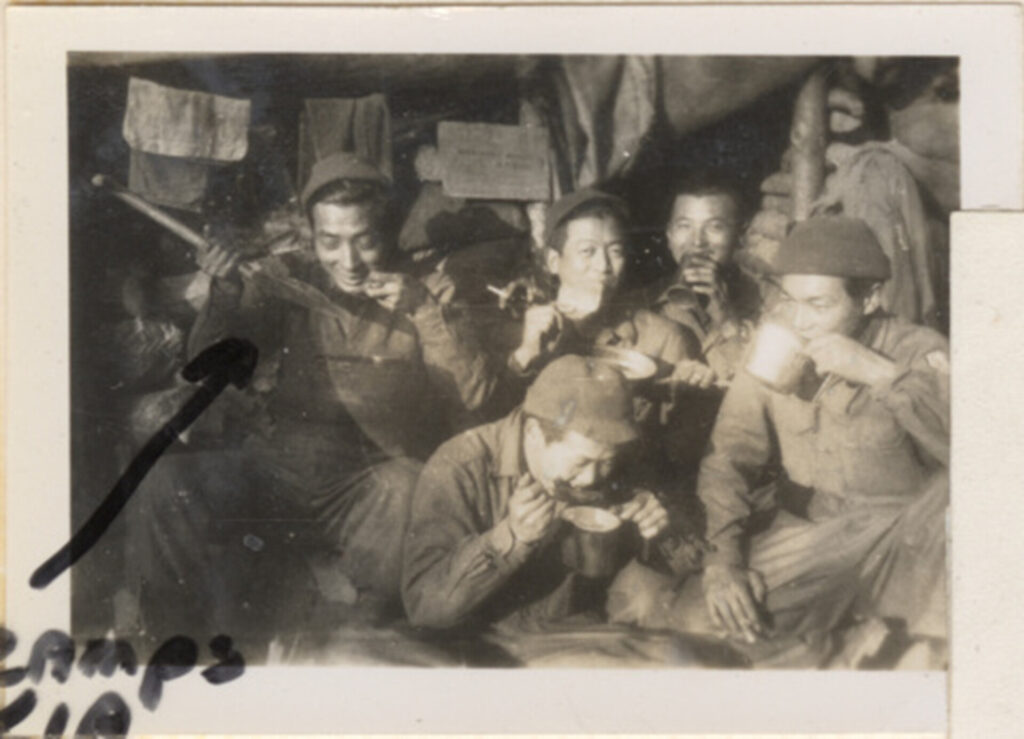
In April 1945, the 442nd was part of the Allied forces pursuing the German Army north in the Po Valley in Italy. On April 13, as they approached Mount Pizzacuto, north of Carrara, the Germans unleashed a fury of artillery. Although I Company was in reserve, they too came under a heavy barrage. On April 14, 1945, Iwamasa was shot by an enemy rifleman in the general thorax region. He was taken to a field hospital where he died and was pronounced a battle casualty. The hospital record only states the date as April 1945. The Germans surrendered in Italy on May 2 and on May 7 to the Allies in Europe.
Private First Class Yoshio Iwamasa was buried in the U.S. Military Cemetery at Castelfiorentino, Italy. On May 12, 1945, his family held memorial services at their home in Niulii and at the home of son Sadaichi Iwamasa at 2222 Young Street in Honolulu. On May 27, a memorial service for Iwamasa and Tech Sergeant Gordon K. Takasaki (E Company), sponsored by the AJA Morale Committee, was held at Kalahikiola Church in Kapaau at 2:00 p.m. The Reverend Lloyd Davis presided, J. Scott B. Pratt spoke on behalf of North Kohala District, and a U.S. Marine chaplain gave the sermon. The men were eulogized by Torakazu Kinoshita and K. Hashimoto, respectively.
For his military service, Private First Class Yoshio Iwamasa was awarded the Bronze Star Medal, Purple Heart Medal with one oak leaf cluster, Good Conduct Medal, American Campaign Medal, European-African-Middle Eastern Campaign Medal with four bronze stars, World War II Victory Medal, Distinguished Unit Badge, and Combat Infantryman Badge.
Yoshio Iwamasa was posthumously awarded the Congressional Gold Medal on October 5, 2010, along with the other veterans of the 100th/442nd Regimental Combat Team. This is the highest Congressional Civilian Medal.
In 1948 the Army began the process of closing the smaller military cemeteries in Italy and offering families the choice of reburial of their loved one at the large U.S. Military Cemetery in Florence or returning home for reburial at a cemetery designated by the family. Iwamasa’s family chose to have him returned.
Pfc. Iwamasa’s remains arrived on December 24, 1948, on the USAT Sinnett to Dock M-3 at Pearl Harbor with 121 other of Hawaii’s war dead. Over 700 family and friends were waiting on the pier where the 265th Army Band played Aloha Oe as the ship docked at 8:30 a.m. They were eulogized in a shipside service by the Secretary of Hawaii, Oren E. Long, who said, “We are proud to have had such sons. These men stood the test of action and added a new chapter of American heroism to our history.” The caskets were taken to the Army mausoleum on Oahu awaiting burial arrangements.
Below: Mrs. Iwamasa in front of her son’s casket, July 22, 1949
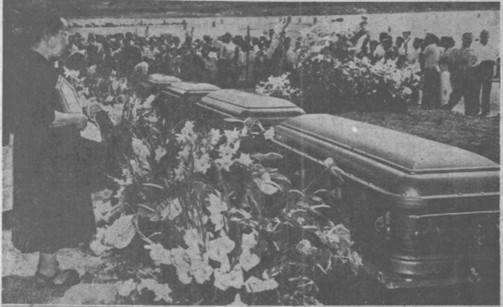
Private First Class Yoshio Iwamasa was buried at 9:30 a.m. on July 22, 1949, in the newly opened National Memorial Cemetery of the Pacific, Section D, Site 213. His burial was held at the same time as the burials of four other war dead from Kohala and was the first interment of 442nd soldiers at Punchbowl. A total of 20 burials, mostly from the 442nd, were scheduled for that day. A memorial service was held at the base of the cemetery’s flag pole prior to the burials. Present were Col. Charles W. Pence (442nd RCT), Col. Farrant L. Turner (100th Infantry Battalion, Separate), and Chaplain Hiro Higuchi (442nd RCT). Pfc. Iwamasa’s mother, Mrs. Tsugi Iwamasa, was present for the burial.
The following day, the new 442nd Veterans Club Memorial Hall at 933 Wiliwili Street was dedicated to the memory of all Hawaii servicemen who died in World War II. Col. Pence, the Combat Team’s former commander, gave the dedicatory address and Chaplain Higuchi gave the invocation.
Pfc. Iwamasa’s gravestone was ordered on February 23, 1950, from West Chelmsford, Massachusetts. His name appears on the wall at the Japanese American Memorial located at the intersection of D Street NW and New Jersey Avenue in Washington, D.C.
Two brothers served with the 442nd RCT: Haruto Iwamasa, 522nd Field Artillery Battalion, B Battery; Masao Iwamasa, 2nd Battalion, F Company.
Listen to the oral interview of Barney Hajiro for a description of the Lost Battalion and further references to Yoshio Iwamasa: https://ndajams.omeka.net/collections/show/383
Researched and written by the Sons & Daughters of the 442nd Regimental Combat Team in 2020, and updated with assistance from the Iwamasa family in 2021 and 2023.